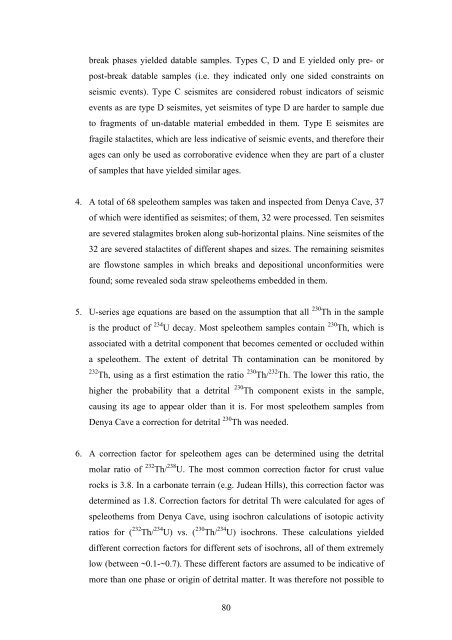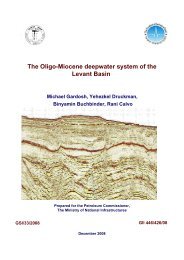tivity on the carmel faul
tivity on the carmel faul
tivity on the carmel faul
You also want an ePaper? Increase the reach of your titles
YUMPU automatically turns print PDFs into web optimized ePapers that Google loves.
eak phases yielded datable samples. Types C, D and E yielded <strong>on</strong>ly pre- or<br />
post-break datable samples (i.e. <strong>the</strong>y indicated <strong>on</strong>ly <strong>on</strong>e sided c<strong>on</strong>straints <strong>on</strong><br />
seismic events). Type C seismites are c<strong>on</strong>sidered robust indicators of seismic<br />
events as are type D seismites, yet seismites of type D are harder to sample due<br />
to fragments of un-datable material embedded in <strong>the</strong>m. Type E seismites are<br />
fragile stalactites, which are less indicative of seismic events, and <strong>the</strong>refore <strong>the</strong>ir<br />
ages can <strong>on</strong>ly be used as corroborative evidence when <strong>the</strong>y are part of a cluster<br />
of samples that have yielded similar ages.<br />
4. A total of 68 speleo<strong>the</strong>m samples was taken and inspected from Denya Cave, 37<br />
of which were identified as seismites; of <strong>the</strong>m, 32 were processed. Ten seismites<br />
are severed stalagmites broken al<strong>on</strong>g sub-horiz<strong>on</strong>tal plains. Nine seismites of <strong>the</strong><br />
32 are severed stalactites of different shapes and sizes. The remaining seismites<br />
are flowst<strong>on</strong>e samples in which breaks and depositi<strong>on</strong>al unc<strong>on</strong>formities were<br />
found; some revealed soda straw speleo<strong>the</strong>ms embedded in <strong>the</strong>m.<br />
5. U-series age equati<strong>on</strong>s are based <strong>on</strong> <strong>the</strong> assumpti<strong>on</strong> that all 230 Th in <strong>the</strong> sample<br />
is <strong>the</strong> product of 234 U decay. Most speleo<strong>the</strong>m samples c<strong>on</strong>tain 230 Th, which is<br />
associated with a detrital comp<strong>on</strong>ent that becomes cemented or occluded within<br />
a speleo<strong>the</strong>m. The extent of detrital Th c<strong>on</strong>taminati<strong>on</strong> can be m<strong>on</strong>itored by<br />
232 Th, using as a first estimati<strong>on</strong> <strong>the</strong> ratio 230 Th/ 232 Th. The lower this ratio, <strong>the</strong><br />
higher <strong>the</strong> probability that a detrital 230 Th comp<strong>on</strong>ent exists in <strong>the</strong> sample,<br />
causing its age to appear older than it is. For most speleo<strong>the</strong>m samples from<br />
Denya Cave a correcti<strong>on</strong> for detrital 230 Th was needed.<br />
6. A correcti<strong>on</strong> factor for speleo<strong>the</strong>m ages can be determined using <strong>the</strong> detrital<br />
molar ratio of 232 Th/ 238 U. The most comm<strong>on</strong> correcti<strong>on</strong> factor for crust value<br />
rocks is 3.8. In a carb<strong>on</strong>ate terrain (e.g. Judean Hills), this correcti<strong>on</strong> factor was<br />
determined as 1.8. Correcti<strong>on</strong> factors for detrital Th were calculated for ages of<br />
speleo<strong>the</strong>ms from Denya Cave, using isochr<strong>on</strong> calculati<strong>on</strong>s of isotopic ac<str<strong>on</strong>g>tivity</str<strong>on</strong>g><br />
ratios for ( 232 Th/ 234 U) vs. ( 230 Th/ 234 U) isochr<strong>on</strong>s. These calculati<strong>on</strong>s yielded<br />
different correcti<strong>on</strong> factors for different sets of isochr<strong>on</strong>s, all of <strong>the</strong>m extremely<br />
low (between ~0.1-~0.7). These different factors are assumed to be indicative of<br />
more than <strong>on</strong>e phase or origin of detrital matter. It was <strong>the</strong>refore not possible to<br />
80

















